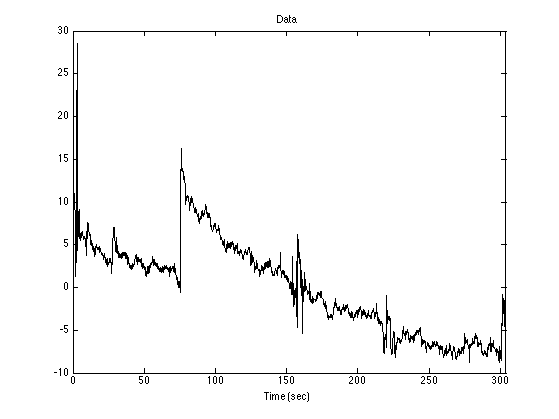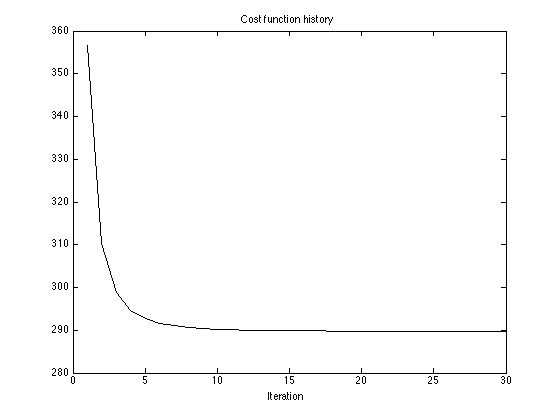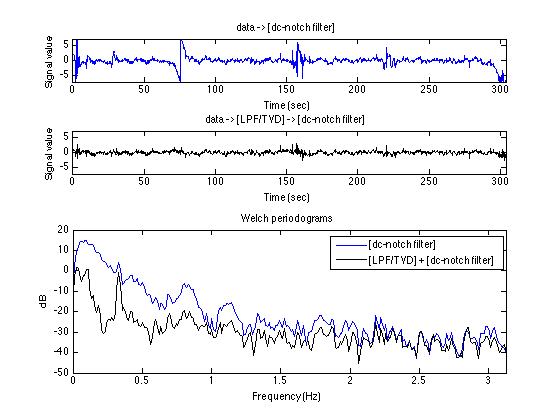LPFTVD_Example_2
Filtering NIRS time-series data with the LPF/TVD algorithm.
The main parameters are:
- d : Low-pass filter order = 2d
- fc : Low-pass filter cut-off frequency (in cycles/sample)
- lam0, lam1 : regularization parameters
Ivan Selesnick, Polytechnic Institute of NYU, June 2012
Contents
Start
clear % close all printme = @(filename) print('-dpdf', sprintf('figures/LPFTVD_Example_2_%s', filename));
Load data
y = load('wl2_col38.txt'); Fs = 6.25; % Fs : sampling rate (samples/second) N = length(y); n = 1:N; t = n/Fs; figure(1) clf plot(t, y); xlim([0 N/Fs]) ax1 = axis; axis(ax1); title('Data') xlabel('Time (sec)')

Set filter parameters
Set filter parameters, fc and d.
fc = 0.02; % fc : cut-off frequency (cycles/sample) (0 < fc < 0.5); d = 1; % d : filter order parameter (d = 1, 2, or 3) fprintf('LPF cut-off frequency: %f cycles/sec \n', fc * Fs);
LPF cut-off frequency: 0.125000 cycles/sec
Run LPF/TVD algorithm
lam = 1.2; % lam : positive regularization parameter Nit = 30; % Nit : number of iterations [x, f, cost] = lpftvd(y, d, fc, lam, Nit); % Run LPF/TVD algorithm txt = sprintf('fc = %.2e, d = %d, lam = %.2e', fc, d, lam); if 0 % Run-time computation tic for ii = 1:50 [x_, f_, cost_] = lpftvd(y, d, fc, lam, Nit); end run_time = toc/50; fprintf('LPF/TVD run-time: %.4f seconds (length = %d samples, %d iterations)\n', run_time, length(y), Nit); end
Display cost function history
figure(1) clf plot(cost) title('Cost function history'); xlabel('Iteration')

Display output of LPF/TVD
figure(2) clf subplot(3, 1, 1) plot(t, y) xlim([0 N/Fs]) ax = axis; title('Data') axis(ax) xlabel('Time (sec)') subplot(3, 1, 2) plot(t, x) title('TVD component [Output of LPF/TVD algorithm]') xlim([0 N/Fs]) xlabel(txt) axis(ax) xlabel('Time (sec)') subplot(3, 1, 3) plot(t, y - x) xlim([0 N/Fs]) xlabel('Time (sec)') title('Data with TVD component subtracted') orient tall printme('lpftvd')

Dc-notch filtering
Apply dc-notch filter for baseline removal. Compute the periodogram after baseline removal. Do the same for data with TVD component subtracted.
y2 = y - x; % y2 : data with TVD component subtracted b = [1 -1]; % b, a : coefficients of dc-notch filter a = [1 -0.96]; g = filtfilt(b, a, y); % apply dc-notch filter to y g2 = filtfilt(b, a, y2); % apply dc-notch filter to y2 G = pwelch(g); % Welch periodograms G2 = pwelch(g2); L = length(G2) - 1; f = (0:L)/L * Fs/2; % f : frequency axis for periodograms
Display periodograms
Display signals and periodograms with and without LPF/TVD processing to remove TV component.
figure(5) clf subplot(4, 1, 1) plot(t, g, 'b') xlim([0 N/Fs]) xlim2 = [-7 7]; ylim(xlim2) title('data -> [dc-notch filter]') xlabel('Time (sec)') ylabel('Signal value') subplot(4, 1, 2) plot(t, g2, 'k') ylim(xlim2) xlim([0 N/Fs]) title('data -> [LPF/TVD] -> [dc-notch filter]') xlabel('Time (sec)') ylabel('Signal value') subplot(2, 1, 2) plot(f, 20*log10(G), 'b' ) line(f, 20*log10(G2), 'color', 'k' ); xlabel('Frequency (Hz)') ylim([-50 20]) title('Welch periodograms') legend('[dc-notch filter]', '[LPF/TVD] + [dc-notch filter]') ylabel('dB') xlim([0 Fs/2]) orient tall printme('welch')
